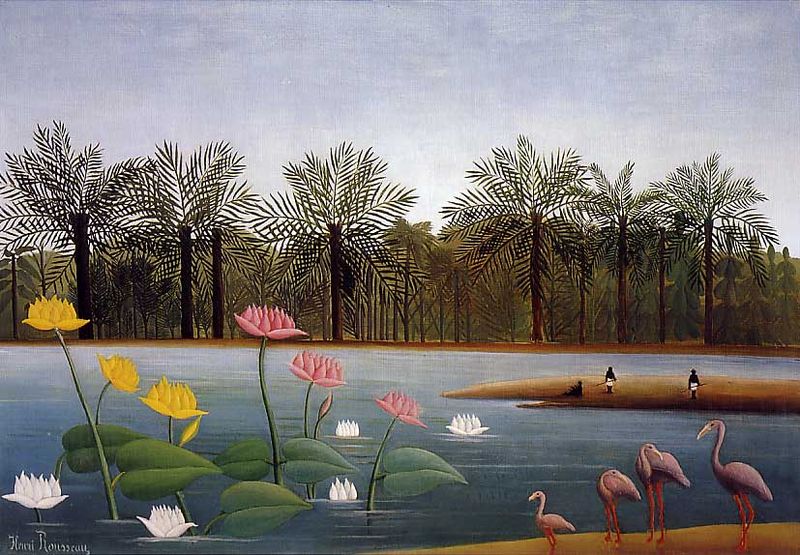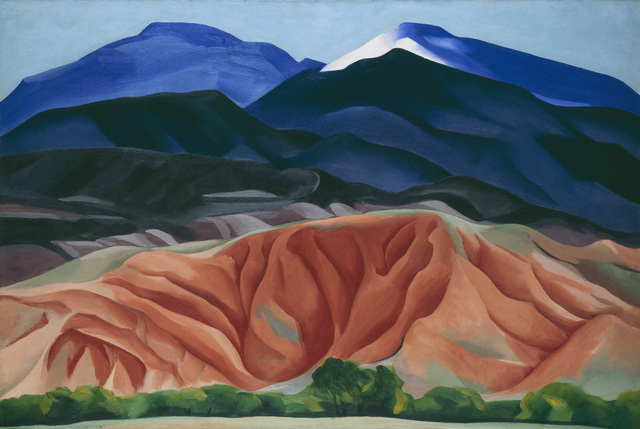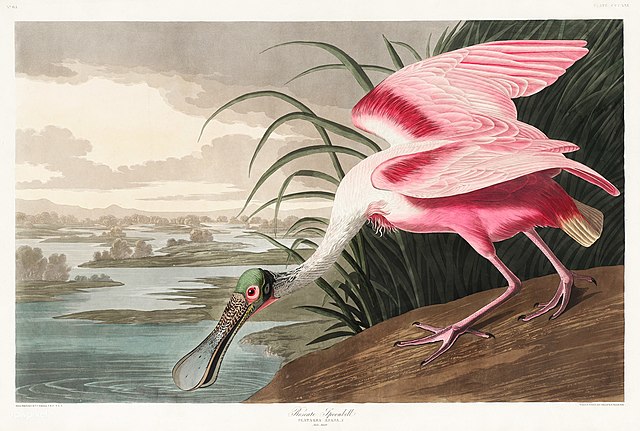10 Most Famous Nature Paintings
Throughout human history, much of our art can exist traced back to depictions of nature in some form or some other. Many of the most popular styles of painting have all touched on natural scenes including animals, landscapes, trees, flowers and nearly annihilation else plant in the wild dazzler of Earth.
Some of the greatest artists in history accept sought to portray nature in various methods including some that adhere to a high level of realism, or watercolor paintings that focus heavily on the natural hues of different creatures and establish life.
Nature has ofttimes served every bit an avenue of inspiration for many pop painters at some signal during their lives.
Few artists take possessed the ability to capture nature in all its rare splendor, but some managed to create works that highlight some of the near awe-inspiring aspects of nature. Here are 10 of the near famous nature paintings in history.
Famous Nature Paintings
1. H2o Lilies – Claude Monet

Claude Money devoted a large portion of his career as an artist to painting various scenes of his ain flower garden, which he took great pride in and maintained.
His work titled Water Lilies was painted in 1906 every bit part of an extended series of famous paintings that depict the many different scenes of natural splendor in the garden.
Monet began painting works that featured different angles from his garden with some focusing on the creative person's small pond and footbridge. Through the years, Monet sought to delve deeper into exactly what made these scenes so highly-seasoned with their colorful allure.
Water Lilies is a specific painting that is totally devoted to the h2o in his garden and the many unlike lily pads that are scattered throughout the pond.
These works were highly praised by art critics and enthusiasts for their securely colorful portrayal of serene natural observations. Monet was able to capture the garden in all its beauty with compositions that are nearly unrivaled when one considers the most famous nature paintings in history.
2. Tiger in a Tropical Storm (Surprised!) – Henri Rousseau

Henri Rousseau began his art career on the outside of the circle of pop artists and critics in his day.
His work titled Tiger in a Tropical Storm (Surprised!) was one of his early paintings and was derided by some critics as being as well childish. However, some fine art lovers saw the many different colorful layers equally one that deserved adoration when it was get-go displayed in 1891.
The painting features a tiger in the midst of a powerful storm, readying itself to pounce on an unknown victim. Rousseau would afterward annotate that the tiger was preparing to attack a grouping of explorers. His use of many different green tones shows the lush, circuitous nature of the jungle.
Many art enthusiasts since then have lauded Rousseau'due south work as it takes a different bending on the often-portrayed jungle. Rousseau used silver paint to represent the raindrops that are shown to be streaming in with an exceptionally strong current of air.
His work was viewed with controversy throughout his lifetime, but since his death Rousseau has risen to the elevation of artists who had a special adoration for nature scenes.
3. Irises – Van Gogh

Vincent Van Gogh was ane of the few artists who had the ability to draw out every bit of significance from the different colors and hues of natural objects. Many of his works focused on flowers, but his painting titled Irises was exceptionally famous among those who enjoy nature paintings.
Irises was painted in 1889 after Van Gogh had endured an especially dark time in his personal struggle with mental illness. He often engaged in self mutilation, famously cutting off his ear in one instance, before beingness admitted to an asylum in Saint-Rémy, French republic. There, he would paint more than 100 works, many focusing on the institution'southward garden.
His piece of work titled Irises was done just a twelvemonth before the artist'south death and was submitted to the Salon des Indépendants by his brother.
four. The Oxbow (The Connecticut River Near Northampton) – Thomas Cole

Thomas Cole painted what many consider to be ane of the well-nigh famous landscape paintings in history in 1836. During a time when people in the America were largely unfamiliar with what lied ahead on the western frontier, Cole'south work beckoned the immature, fledgling nation to look beyond the tales of savages inhabiting the natural world exterior the known borders of their reality and to comprehend the stunning beauty of the natural world before them.
He painted a scene from Mount Holyoke overlooking the Connecticut River known as The Oxbow. The painting features the lush magnificent landscape in all its grandeur with a storm approaching the calm valley below.
This work was highly popular from the moment information technology was first exhibited for the creative person's power to show the true beauty that so many people appreciated about the region.
five. Road Nearly Mont Sainte-Victoire – Paul Cezanne

Paul Cezanne was legendary amongst painters in the Post-Impressionist movement and would be role of the reason that sparked Cubism as well.
He painted Route Near Mont Sainte-Victoire onetime between 1902 and 1904 and was widely heralded for his unique interpretation of natural shapes and angles, painting them in different geometric patterns.
Cezanne painted a number of works focused on the Mont Sainte-Victoire, but this 1 managed to draw considerable amounts of attending cheers to the artist's apply of vibrant green colors set amidst the quiet blue tones of the mountain background.
6. Looking Down Yosemite Valley – Albert Bierstadt

Few places on Earth are as awe-inspiring equally California's Yosemite Valley. Albert Bierstadt was i of the simply landscape artists who has ever managed to capture a scene that closely resembles the valley'due south immaculate vistas.
His work titled Looking Downwards Yosemite Valley was finished in 1865 and features a scene that'due south framed with monumental rock formations on either side of a broad, sweeping valley beneath.
The piece of work was highly touted for its incredibly realistic portrayal of Yosemite's natural dazzler, especially the manner in which the setting sun shines from effectually the edge of the sheer stone face on the right of the painting.
seven. The Peachy Moving ridge off Kanagawa – Katsushika Hokusai

1 of the near iconic works of Japanese art is Katsushika Hokusai's work titled The Peachy Wave off Kanagawa. Painted erstwhile between 1830 and 1833, Hokusai's work focuses solely on the raging seas well-nigh the state's famous Mountain Fugi.
The painting was part of a wider series of works the artist dubbed 30-Six Views of Mount Fuji.
Hokusai depicts the famous mural with a rare perspective that focuses more than on the rolling waves on the nearby ocean. Mount Fuji is curiously noticed in the background, information technology'south white snow-capped pinnacle visible as a giant moving ridge rolls in and breaks.
Hokusai'southward piece of work is famous for the artist's ability to capture the circuitous nature of the bounding main waves in a perspective that was rarely seen by anyone who seldom ventures out on the ocean.
8. The Flamingos – Henri Rousseau

Known for producing works that focused on exotic scenes and animals, Henri Rousseau'southward work known as The Flamingos has long been considered ane of his virtually famous nature scenes. Painted in 1907, Rousseau's mural depicts a calm scene on the banks of a tropical waterway.
Likewise Read: Famous Bird Paintings
The artists never divulged if the location depicted in this work were existent and many of his greatest fans recall he may take been inspired by his exploits in the French Army while in United mexican states.
The painting features a landscape that is divided into different layers that focus on the flowers well-nigh the banks of the h2o with a line of towering palm trees in the distance. Flamingos are seen casually enjoying the water along the banks in a diverseness of dissimilar poses.
9. Black Mesa Mural, New Mexico – Georgia O'Keeffe

Georgia O'Keeffe is famously known equally 1 of the greatest painters in American history, simply her work titled Black Mesa Landscape, New Mexico drew worldwide acclaim for its striking colors and soft undertones.
O'Keeffe painted the work in 1930 and she would after be renown for her ability to capture various scenes and objects related to the American southwest.
The painting features a scene from the Black Mesa region of New United mexican states, which is known for its rugged, unforgiving landscape. O'Keeffe's painting certainly catches the heart of the viewer due to her use of bright, reddish hues in the foreground while the groundwork consists of large mountains that seem to rise from the bottom of the canvas.
10. Roseate Spoonbill – John James Audubon

John James Audubon developed a reputation amongst bird watching and fine art enthusiasts akin as many of his most famous works centered on nature scenes involving diverse avian creatures.
His piece of work titled Roseate Spoonbill incorporated vivid green colors of the spoonbill's pecker that moves into the bird'due south brilliant pinkish feathering. The painting is prepare against a soft blue, watery background that features sparse rock formations.
Likewise Read: Colorful Paintings
Audubon managed to highlight the sharpness of the bird' pink plumes by depicting the creature every bit standing in front end of lush green grass forth the waterside.
The work was function of a serial titled Birds of America, which was exhibited in 1826 and immediately caught the attending of prominent scientists in his 24-hour interval. Thanks to Audubon'due south work, 25 new species of birds were discovered.
Source: https://www.artst.org/famous-nature-paintings/
0 Response to "10 Most Famous Nature Paintings"
Post a Comment